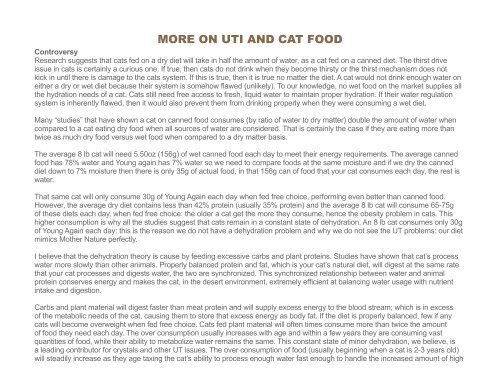REGULAR CAT FOOD COMPARISON CHART
REGULAR CAT FOOD COMPARISON CHART
REGULAR CAT FOOD COMPARISON CHART
You also want an ePaper? Increase the reach of your titles
YUMPU automatically turns print PDFs into web optimized ePapers that Google loves.
MORE ON UTI AND <strong>CAT</strong> <strong>FOOD</strong><br />
Controversy<br />
Research suggests that cats fed on a dry diet will take in half the amount of water, as a cat fed on a canned diet. The thirst drive<br />
issue in cats is certainly a curious one. If true, then cats do not drink when they become thirsty or the thirst mechanism does not<br />
kick in until there is damage to the cats system. If this is true, then it is true no matter the diet. A cat would not drink enough water on<br />
either a dry or wet diet because their system is somehow flawed (unlikely). To our knowledge, no wet food on the market supplies all<br />
the hydration needs of a cat. Cats still need free access to fresh, liquid water to maintain proper hydration. If their water regulation<br />
system is inherently flawed, then it would also prevent them from drinking properly when they were consuming a wet diet.<br />
Many “studies” that have shown a cat on canned food consumes (by ratio of water to dry matter) double the amount of water when<br />
compared to a cat eating dry food when all sources of water are considered. That is certainly the case if they are eating more than<br />
twice as much dry food versus wet food when compared to a dry matter basis.<br />
The average 8 lb cat will need 5.50oz (156g) of wet canned food each day to meet their energy requirements. The average canned<br />
food has 78% water and Young again has 7% water so we need to compare foods at the same moisture and if we dry the canned<br />
diet down to 7% moisture then there is only 35g of actual food, in that 156g can of food that your cat consumes each day, the rest is<br />
water.<br />
That same cat will only consume 30g of Young Again each day when fed free choice, performing even better than canned food.<br />
However, the average dry diet contains less than 42% protein (usually 35% protein) and the average 8 lb cat will consume 65-75g<br />
of these diets each day, when fed free choice: the older a cat get the more they consume, hence the obesity problem in cats. This<br />
higher consumption is why all the studies suggest that cats remain in a constant state of dehydration. An 8 lb cat consumes only 30g<br />
of Young Again each day: this is the reason we do not have a dehydration problem and why we do not see the UT problems: our diet<br />
mimics Mother Nature perfectly.<br />
I believe that the dehydration theory is cause by feeding excessive carbs and plant proteins. Studies have shown that cat’s process<br />
water more slowly than other animals. Properly balanced protein and fat, which is your cat’s natural diet, will digest at the same rate<br />
that your cat processes and digests water, the two are synchronized. This synchronized relationship between water and animal<br />
protein conserves energy and makes the cat, in the desert environment, extremely efficient at balancing water usage with nutrient<br />
intake and digestion.<br />
Carbs and plant material will digest faster than meat protein and will supply excess energy to the blood stream; which is in excess<br />
of the metabolic needs of the cat, causing them to store that excess energy as body fat. If the diet is properly balanced, few if any<br />
cats will become overweight when fed free choice. Cats fed plant material will often times consume more than twice the amount<br />
of food they need each day. The over consumption usually increases with age and within a few years they are consuming vast<br />
quantities of food, while their ability to metabolize water remains the same. This constant state of minor dehydration, we believe, is<br />
a leading contributor for crystals and other UT issues. The over consumption of food (usually beginning when a cat is 2-3 years old)<br />
will steadily increase as they age taxing the cat’s ability to process enough water fast enough to handle the increased amount of high


